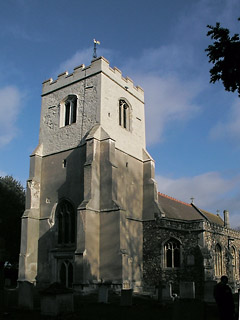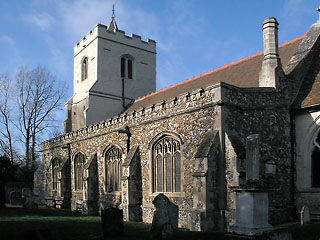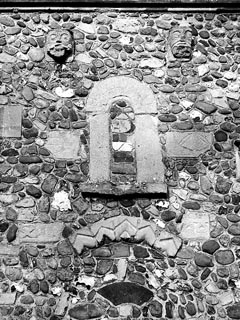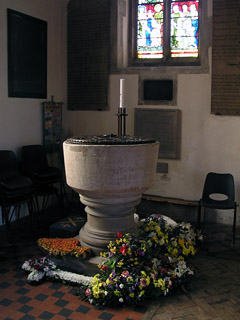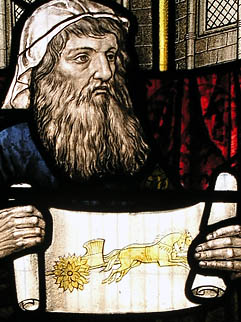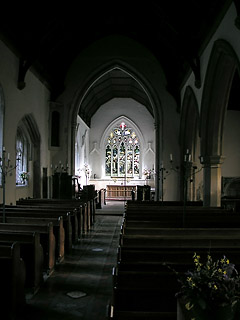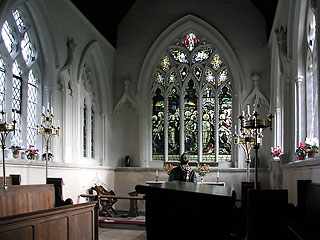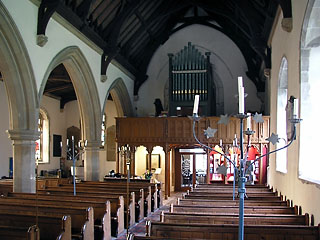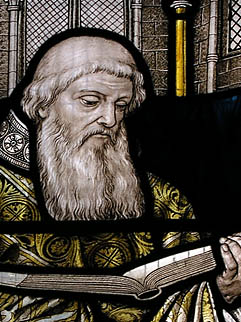Grantchester is a most peculiar place. It’s almost always crawling with visitors, and seems to serve as millionaires’ row for Cambridge. The most famous residents are the Archers, although strictly speaking it’s now only Lady Mary who lives in the Old Vicarage, since Lord Geoffrey has returned to London to try and revive his political career. I would say something about dead donkeys at this point, but it might be libellous. Besides which, one should never underestimate the desperation of the Tory party. Archer for Mayor of London in 2008, anyone?
So, yes, Grantchester. My point is that there’s something of an unreal feeling to the village, or at least to the southern end where tourists go (the council estate at the northern end is a bit more gritty). Go to the Orchard Tea Rooms, where the miasma of privilege is both exemplified and distracted from by the magnificent cream teas.
Also, go to the church – it’s not the finest church around Cambridge, but it is rather interesting. The main impression from the outside is of how long and low it is. There’s no clerestory, and on the north side facing the village there is no aisle, so all one sees is a long whitewashed wall, punctuated by the pretty little porch and the transition from plain nave to rather more magnificent chancel. Closer inspection reveals that the north face was also, once upon a time, broken up by a chapel at the east end of the nave, but that is now long gone: all that remains is the old archway, with a Perpendicular window reset into the wall within.
The tower is also low, and generally looking a bit battered. The stucco is a nice dark sandy colour, but is starting to peel in places, revealing both stonework and patches of bricks that have been used for repairs in the past. An unusual touch is the window at ground level in the west face of the tower, where there would normally be a west door. Like the rest of the church, the tower is no older than the 14th century. However, just round the corner are some fragments which suggest the presence of a much older church at one time.
When the new south aisle was built in the 19th century, they found a number of fragments of Romanesque stonework and set them into the wall at the south-west corner. There is a small round-headed window, some fragments of another arch decorated with chevrons, and several bits of knotwork-pattern borders. There are also a couple of magnificently primitive heads gazing impassively out over the top of the rest. The knotwork and the heads look so old that they could be Saxon, or at least 11th century Norman. However, it’s very difficult to tell from such little evidence.
Entry is through the north porch, which is extremely photogenic – slightly squiffy tiles on the roof and lovely old worm-eaten woodwork on the doorframe and roof. As one might expect from the exterior, the nave is dark – though at first one could be forgiven for thinking that it’s darker than it is because the porch leads out under the organ gallery, which is a rather bland 20th century affair in Strawberry Hill gothic style.
The nave is 15th century, but aside from the windows in the north wall there’s little to see since a big restoration in 1876-7 in which the roof was built and the south aisle built. The nave was so small that the new aisle almost doubled the church in width, and rather dominates the space now. Architecturally I think the addition is awful (the arcade is made of mud-coloured stone and is for some reason inelegant even by the standards of cack-handed restoration), but it does have some interesting bits and bobs in it.
I liked the font at the west end, which is impressively large and severe – effectively just a huge rough bowl. On our most recent visit, it was surrounded by an array of floral tributes, including a charming fish formed of browning chrysanthemums. (Well, I say ‘charming’ – I probably mean ‘deeply disconcerting’). There’s also an interesting model of the church before the aisle was added, with a much flatter nave roof.
Unsurprisingly, the windows in the aisle are High Victorian at its most overpowering. Each window contains the figure of a saint or a prophet; most are both gloomy and uninteresting, but a few caught my eye. Bede is up towards the west end, and there’s a good trio in the easternmost window: Jeremiah brandishes a broken gourd; Isaiah (with a tremendous beard and a very stern expression) wields a sundial; and Elijah holds a scroll depicting the flaming chariot on which he ascended to heaven. This last prompted the rather irreverent comparison with hitchhiking: I wonder how long the bearded prophet had to wait by the side of the M11 holding his scroll before a flaming chariot stopped for him?
Also up at the eastern end of the aisle are some reset bits and bobs from the old south wall of the nave. There’s a wall memorial to George Shepherd, who was a fellow of Clare Hall in Cambridge until he died in 1690 aged only 32 years. The memorial is mostly quite plain, but it has a rounded pediment, crowned with an urn complete with gilded flames bursting from the top. Another reset survival is a chest tomb and niche, now set into the east wall and used as an altar. It looks as though there was once a brass, but nothing now remains to suggest whose it was.
Nothing remains of the rood screen. However, the rood stair survives in the north-east corner of the nave, tucked away behind the 17th century pulpit. It’s also possible here to see very clearly where the north chapel once stood – the present easternmost nave window is smaller than the others and has been reset in a newer wall filling in the old chapel entrance.
The rood screen must have been rather spectacular, especially facing into such a small nave, for the chancel arch marks a sudden change in scale between nave and chancel. For there to be such a change is not unusual, of course. Responsibility for maintaining the nave and chancel was divided, with the rector taking the latter and the parishioners the former. In East Anglia, this often resulted in wealthy parishes paying for spectacular towers and glorious naves which are rather incongruously attached to smaller, older chancels.
It’s less common for the phenomenon to occur the other way round, with a rich chancel sitting next to a rather meagre church. (Whether this is because rectors were less enthusiastic builders, or because they were unable to pull money together as well as groups of parishioners, I’m not entirely sure). Here, though, that is what must have happened: for although the chancel is in the Decorated style and therefore older than the nave, the predecessor to the latter would, if anything, have been even smaller and therefore even more meagre by comparison.
The chancel is a spectacular space, though the effect is completely different to the vista a medieval peasant or priest would have seen. What survives now is large and light and airy: the big side windows are either clear or filled with quite pale glass, and the walls are all whitewashed. Once upon a time, though, the effect would have been richer, and darker: the windows filled with thick medieval glass glinting vermillion and ultramarine, and the walls painted in intense colours. Given the money that was lavished on the building, I don’t doubt that it was generously appointed with gold and fine cloth too.
Given a little imagination, it’s not too hard an act of the imagination to reclothe this particular building and see how it must once have been, for the structure too is unusually decorative. The side walls are pierced with three-light windows crowned with delicate flowing tracery. These windows are separated by double niches, with each pair having an ogeed canopy over the top decorated with dense leaf carving. The effect gives the interior a nice rhythm, but it would be nice to have the niches filled with statues once more. The east window is five-lighted and of similar design to the sides: on either side there is a grand single niche.
Other than that, little of the medieval structure survives. There’s a tomb niche on the north side, now somewhat swamped by the raised floor level, and a piscina on the south. The lower sill of the easternmost south window is very low, and looks as though it once formed a set of sedilia: if there were ever canopies over the seats, though, they are long lost. Otherwise, the character is entirely due to the modern restorations: the modern woodwork and whitewashed walls, and (above all) the modern glass in the east and south windows.
Some bits of these are reasonable: in the east window I loved the backgrounds of moody evening skies and palm trees, depicted in Prussian blue and vivid olivine shades. However, the depictions of Christ are awful: blond, doe-eyed and deeply insipid. To paraphrase Abbot Zerchai in A Canticle for Liebowitz, one could imagine him saying ‘Suffer the little children to come unto me’, but there’s no fire in those vapid eyes, and a worrying hint of aryan supremacism. That might be a little unkind, though, so I’ll echo myself in the previous draft of this entry and call it ‘The Merchant Ivory Life of Christ’.
So, let’s escape to the outside world once more. My favourite things about this church are its churchyards. There are several, separated by lovely old brick walls and gateways, sprawling along between the houses and the fields. Aside from the excitement of exploration, it’s all very beautiful: each space is intimate, and there are some fine plants dotted around. When Mark and I visited in the late winter of 2005 we found a Jerusalem Thorn in bloom, along with a fine display of snowdrops.
My favourite visit, though, was a previous winter – 2003, perhaps – when I woke up one morning and looked out of my window to see the courtyard filled with snow. A friend and I declared an impromptu holiday and went for a walk. It was, at first, beautifully clear, and so we walked along the banks of the Cam, following the familiar route through the fields to Grantchester and marvelling at how different and lovely it looked. We stopped for tea at the Orchard and enjoyed the incongruity of sitting outside in a snowy orchard, and generally felt very happy. Before setting back to Cambridge, we came to the churchyards and walked through to the last one, where the graves peter out at a line of thin lime trees and the fields open out beyond. The sun had gone in while we had drunk our tea, and the sky was darkening again. The fields were white, and the trees were black, and the sky was that odd shade that falls between greys and says: Snow again, very soon. And we stood and looked at the waiting graves, and the waiting fields, and waited until we lost our nerve and headed back for Cambridge.
SS. Andrew and Mary has always been open when we've visited.
